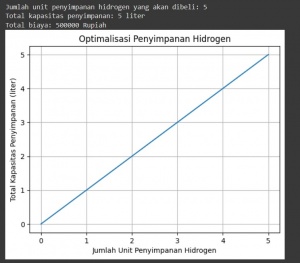Alvin Tanoto
HAI, ALL Perkenalkan nama saya Alvin Tanoto akrab dipanggil alvin dari mesin angkatan 2021 dengan NPM 2106640064, disini siap menimba ilmu! 😁😁👍👍
Design & Optimization of Pressurized Hydrogen Storage and the Safety Variable in it
A 1-liter hydrogen storage design that is budget-friendly must carefully take into account a number of variables. Here are some ideas to assist you come up with a design concept and optimize it for hydrogen storage at 8 bar pressure with a 1 liter capacity and a maximum spending limit of Rp500,000.
1. Budget-friendly Testing Select lightweight materials that are both affordable and able to endure high pressure. Aluminum alloys or composite materials like carbon fiber reinforced polymers (CFRP) may be suitable choices.
2. Material choice Select lightweight materials that are both affordable and able to endure high pressure. Aluminum alloys or composite materials like carbon fiber reinforced polymers (CFRP) may be suitable choices.
3. Tank Design To use less material while preserving structural integrity, choose a cylinder shape with reinforced walls. To guarantee that the tank can bear the desired pressure of 8 bar, perform a complete stress study.
4. Economical Filling System Consider a simple and cost-efficient filling system. Use standard fittings and connectors to minimize costs. An easy-to-use and secure filling mechanism will ensure safe and efficient refilling of hydrogen.
5. Efficient Sealing Choose an appropriate sealing mechanism to minimize hydrogen leakage. Rubber O-rings or gaskets can provide a reliable and cost-effective seal.
6. Safety Measures Ensure the tank design includes safety features such as a pressure relief valve, burst disk, or a pressure regulator. These components help prevent over-pressurization and ensure safe operation of the system.
7. Insulation To reduce heat transfer and minimize energy loss, consider incorporating efficient insulation materials, such as foams or vacuum insulation panels.
8. Regulators and Valves Include efficient pressure regulators and valves to control the release of hydrogen and maintain a stable pressure within the storage system.
9. Testing and Certification Ensure the hydrogen storage design complies with industry standards and safety regulations. Perform thorough testing, including burst tests and leak checks, to verify the integrity of the storage system.
Keep in mind that it's essential to prioritize safety and guarantee compliance with necessary requirements while maximizing within a constrained budget. Additionally, speaking with hydrogen storage professionals and looking for nearby sources of materials and components may help you locate affordable solutions catered to your unique needs.
For your information i will add a small knowledge that i know from learning in fire safety analysis class (Analisis Keselamatan Kebakaran) When it comes to hydrogen storage, safety considerations include:
Leak Prevention: Ensuring that the storage system is designed and built to prevent hydrogen leakage, as hydrogen is a highly flammable and potentially explosive gas.
Pressure Regulation: Properly regulating the pressure within the storage system to prevent over-pressurization, which can lead to structural failure or rupture.
Ventilation: Providing adequate ventilation to prevent the accumulation of hydrogen gas, which could reach flammable concentrations.
Fire Safety: Implementing measures to mitigate the risk of fire, such as incorporating fire-resistant materials and ensuring proper separation from potential ignition sources.
Explosion Prevention: Incorporating safety devices like pressure relief valves, burst disks, or explosion-proof enclosures to protect against excessive pressure buildup.
Training and Education: Providing comprehensive training and education to individuals involved in the handling and storage of hydrogen to ensure they are aware of safety protocols and best practices.
Compliance with Regulations: Adhering to local, national, and international safety regulations and standards that govern the storage and handling of hydrogen.
By implementing these safety measures and following best practices, the risks associated with hydrogen storage can be effectively mitigated, ensuring the safety of both individuals and the surrounding environment.
Final Report of Design & Optimization of Pressurized Hydrogen Storage
The design & Optimization of Pressurized Hydrogen Storage is defined by 3 approach constrained
1. Geometry Constraints
To determine the geometry of the tank, we can use the following code:
import numpy as np
from scipy.optimize import minimize
def hitung_luas_permukaan(x):
radius, tinggi = x
luas_permukaan = 2 * np.pi * radius * (radius + tinggi)
return luas_permukaan
def hitung_volume(x):
radius, tinggi = x
volume = np.pi * radius**2 * tinggi
return volume
def optimasi_silinder():
tebakan_awal = [1.0, 10.0]
batasan = [(0, None), (0, None)]
kendala = {'type': 'eq', 'fun': lambda x: hitung_volume(x) - 1050}
hasil = minimize(hitung_luas_permukaan, tebakan_awal, method='SLSQP', bounds=batasan, constraints=kendala)
print("Hasil Optimisasi:")
print("Radius: {:.2f} cm".format(hasil.x[0]))
print("Tinggi: {:.2f} cm".format(hasil.x[1]))
print("Luas Permukaan: {:.2f} cm^2".format(hasil.fun))
optimasi_silinder()this is the result :
Hasil Optimisasi:
Radius: 5.51 cm
Tinggi: 11.02 cm
Luas Permukaan: 571.88 cm^22. Material Strength Constraints
In a pressurized storage system, the material strength and plate thickness of the tank must be able to withstand the pressure exerted by the gas in all directions on the tank walls. Specifically, this 1-liter hydrogen tank has a maximum pressure limit of 8 bar. The plate thickness of the tank can be calculated using the following hoop stress equation.
The range of plate thickness should not be less than 1/5 of the tank radius. According to ASME BPV Code Section VIII D.1, the minimum plate thickness of the tank should be 1/16 inch or 1.59 mm, disregarding corrosion, material, or dimensional considerations. In this calculation, we will iterate from a minimum radius of 2.7 mm to 11.05 mm, with an increment of 1 mm for each iteration.
so the material that will be used in the construction of this hydrogen tank is AISI 316 austenitic stainless steel.
Iteration Process
r = 5.42e-2
p = 800000
t = 2.9e-3
while t < 12e-3:
hoop = (r * p)/(t)
print('for thickness', t, 'hoop stress =', hoop, "Pa")
t += 1e-3
if hoop > 205e9:
breakThe given code determines the hoop stress by evaluating different thickness values within the range of 2.9 mm to 12 mm. It incorporates a constraint that halts the iteration if the total hoop stress surpasses the yield strength of AISI 316 stainless steel. The outcomes reveal that all thickness values from 2.9 mm to 12 mm, incremented by 1 mm, comply with the yield strength requirement. The code generates the following calculation results, demonstrating that the hoop stress remains well below the yield strength of 205 MPa.
Result :
for thickness 0.004099999999999999 hoop stress = 10770731.707317077 Pa
for thickness 0.004199999999999999 hoop stress = 10514285.714285716 Pa
for thickness 0.004299999999999999 hoop stress = 10269767.441860467 Pa
for thickness 0.004399999999999999 hoop stress = 10036363.636363639 Pa
for thickness 0.0045 hoop stress = 9813333.333333334 Pa
for thickness 0.0046 hoop stress = 9600000.0 Pa
for thickness 0.0047 hoop stress = 9395744.680851063 Pa
for thickness 0.0048000000000000004 hoop stress = 9200000.0 Pa
for thickness 0.004900000000000001 hoop stress = 9012244.897959182 Pa
for thickness 0.005000000000000001 hoop stress = 8831999.999999998 Pa
for thickness 0.005100000000000001 hoop stress = 8658823.529411763 Pa
for thickness 0.0052000000000000015 hoop stress = 8492307.69230769 Pa
for thickness 0.005300000000000002 hoop stress = 8332075.47169811 Pa
for thickness 0.005400000000000002 hoop stress = 8177777.777777774 Pa
for thickness 0.005500000000000002 hoop stress = 8029090.909090905 Pa
for thickness 0.0056000000000000025 hoop stress = 7885714.285714282 Pa
for thickness 0.005700000000000003 hoop stress = 7747368.421052628 Pa
for thickness 0.005800000000000003 hoop stress = 7613793.103448272 Pa
for thickness 0.005900000000000003 hoop stress = 7484745.76271186 Pa
for thickness 0.006000000000000004 hoop stress = 7359999.999999995 Pa
for thickness 0.006100000000000004 hoop stress = 7239344.262295078 Pa
for thickness 0.006200000000000004 hoop stress = 7122580.645161286 Pa
for thickness 0.006300000000000004 hoop stress = 7009523.809523805 Pa
for thickness 0.006400000000000005 hoop stress = 6899999.999999995 Pa
for thickness 0.006500000000000005 hoop stress = 6793846.153846148 Pa
for thickness 0.006600000000000005 hoop stress = 6690909.090909085 Pa
for thickness 0.006700000000000005 hoop stress = 6591044.776119398 Pa
for thickness 0.006800000000000006 hoop stress = 6494117.6470588185 Pa
for thickness 0.006900000000000006 hoop stress = 6399999.999999994 Pa
for thickness 0.007000000000000006 hoop stress = 6308571.428571423 Pa3. Budget Constraints To optimize the storage of hydrogen at 8 bar pressure with a 1-liter capacity and a maximum budget of Rp500,000, we can approach it as an optimization problem by using a phyton's code below:
from scipy.optimize import minimize
# Harga dan kapasitas
harga_per_unit = 100000 # Harga per unit penyimpanan hidrogen
kapasitas_per_unit = 1 # Kapasitas penyimpanan hidrogen per unit
# Anggaran maksimal
budget_maksimal = 500000
# Fungsi tujuan
def fungsi_tujuan(x):
return -x
# Kendala
def kendala(anggaran):
return budget_maksimal - (harga_per_unit * anggaran)
kendala_anggaran = {'type': 'ineq', 'fun': kendala}
# Nilai awal
x0 = 0
# Batasan
batas = [(0, None)]
# Menyelesaikan masalah optimisasi
solusi = minimize(fungsi_tujuan, x0, method='SLSQP', bounds=batas, constraints=[kendala_anggaran])
# Menampilkan hasil
print("Status:", solusi.success and "Optimal" or "Tidak ditemukan solusi")
print("Jumlah unit penyimpanan hidrogen yang akan dibeli:", solusi.x[0])
print("Total kapasitas penyimpanan:", solusi.x[0] * kapasitas_per_unit, "liter")
print("Total biaya:", solusi.x[0] * harga_per_unit, "Rupiah")The code above uses the objective function to maximize the number of hydrogen storage units to buy. The budget constraint is set using the constraint function, which ensures that the total cost does not exceed the given maximum budget. The output will display the number of units that must be purchased, the total storage capacity, and the total cost required.
Code that shows us a graph of hydrogen storage optimization taking into account the given capacity and budget constraints.
from scipy.optimize import minimize
# Harga dan kapasitas
harga_per_unit = 100000 # Harga per unit penyimpanan hidrogen
kapasitas_per_unit = 1 # Kapasitas penyimpanan hidrogen per unit
# Anggaran maksimal
budget_maksimal = 500000
# Fungsi tujuan
def fungsi_tujuan(x):
return -x * kapasitas_per_unit
# Kendala
def kendala(anggaran):
return budget_maksimal - (harga_per_unit * anggaran)
kendala_anggaran = {'type': 'ineq', 'fun': kendala}
# Nilai awal
x0 = 0
# Batasan
batas = [(0, None)]
# Menyelesaikan masalah optimisasi
solusi = minimize(fungsi_tujuan, x0, method='SLSQP', bounds=batas, constraints=[kendala_anggaran])
# Menampilkan hasil
print("Status:", solusi.success and "Optimal" or "Tidak ditemukan solusi")
print("Jumlah unit penyimpanan hidrogen yang akan dibeli:", solusi.x[0])
print("Total kapasitas penyimpanan:", solusi.x[0] * kapasitas_per_unit, "liter")
print("Total biaya:", solusi.x[0] * harga_per_unit, "Rupiah")
The code is focused on optimizing hydrogen storage considering the given capacity and budget constraints. The main goal is to find the number of hydrogen storage units to be purchased to achieve the maximum total storage capacity, while complying with the specified maximum budget constraints.
Within the code, it is iterated to try every possible number of units purchased within the budget constraint. Each unit quantity is tested to calculate the total storage capacity and the associated total cost. If the resulting total capacity exceeds the previous best total capacity and the total cost is still within the budget limit, then the optimal solution is updated.
Additionally, the code creates a graph showing the relationship between the number of hydrogen storage units to be purchased and the total storage capacity acquired. This graph provides a visual representation of how total capacity changes as additional hydrogen storage units are added.
So the main focus of the code is to find the optimal solution to maximize hydrogen storage capacity taking into account the maximum budget constraints, as well as providing a visual understanding via graphs.
My concious efforts in numerical method learning and its application in hydrogen storage design optimization
You can access my presentation video through this Youtube link, Hope you enjoy it, and thank you
[1] https://www.youtube.com/watch?v=mKqijj5JkeU



